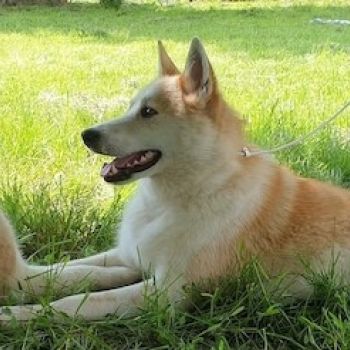The West Siberian Laika is a versatile and robust dog breed that hails from the vast and rugged region of West Siberia in Russia. Known for their exceptional hunting skills and adaptability to extreme climates, these dogs have become highly valued companions and working dogs for the indigenous people of the area. With their striking appearance and impressive abilities, the West Siberian Laika has gained recognition and admiration worldwide.
The history of the West Siberian Laika dates back centuries, with its origins rooted in the ancient hunting dogs of the indigenous tribes of Siberia. These dogs were selectively bred for their hunting prowess, endurance, and ability to navigate through the harsh Siberian terrain. Over time, the breed developed into a distinct type, known for its versatility and adaptability.
According to the FCI (Fédération Cynologique Internationale) typology, the West Siberian Laika belongs to Group 5, which includes Spitz and primitive types of dogs. Within this group, the breed is classified under Section 2 - Nordic Hunting Dogs. This classification highlights the breed's hunting abilities and its close association with the indigenous people of Siberia.
The West Siberian Laika is primarily used for hunting various game, including small mammals, birds, and even larger prey such as bears and boars. Their exceptional scenting abilities, agility, and endurance make them well-suited for tracking and retrieving game in the challenging Siberian wilderness. Additionally, these dogs have also been utilized for herding reindeer and guarding livestock.
In terms of physical characteristics, the West Siberian Laika is a medium-sized dog with a well-muscled and sturdy build. Males typically stand between 21 to 24 inches (53 to 61 cm) at the shoulder, while females are slightly smaller, ranging from 20 to 23 inches (51 to 58 cm). The breed's weight ranges from 40 to 60 pounds (18 to 27 kg), with males generally being larger and heavier than females.
One notable feature of the West Siberian Laika is its dense double coat, which provides excellent insulation against the harsh Siberian climate. The outer coat is straight and coarse, while the undercoat is thick and soft. This coat allows the breed to withstand extremely low temperatures, making them well-suited for their native environment.
In terms of color, the West Siberian Laika can come in various shades, including white, black, gray, red, and piebald. The breed's coat color often reflects the specific needs of the hunting environment, with lighter colors being more prevalent in snowy regions and darker colors in forested areas.
The average lifespan of a West Siberian Laika is around 12 to 15 years, which is relatively long for a medium-sized dog breed. This longevity can be attributed to their robust health and the breed's natural adaptation to the harsh Siberian environment. However, like all dogs, they can be prone to certain health issues, including hip dysplasia and eye problems. Regular veterinary check-ups and a balanced diet are essential for maintaining their overall well-being.
Aside from their exceptional hunting abilities and physical attributes, the West Siberian Laika is known for its intelligence, loyalty, and strong bond with its human family. They are highly trainable and eager to please, making them suitable for various activities such as obedience trials, agility competitions, and search and rescue work. However, it is important to note that their strong hunting instincts may require early socialization and consistent training to ensure they can adapt to different environments and interact appropriately with other animals and people.
In conclusion, the West Siberian Laika is a remarkable dog breed that embodies the resilience and adaptability required to thrive in the harsh Siberian wilderness. With their striking appearance, exceptional hunting skills, and loyal nature, they have become cherished companions and working dogs for people around the world. Whether as a hunting partner or a loving family pet, the West Siberian Laika continues to captivate the hearts of dog enthusiasts with its unique blend of strength, intelligence, and unwavering loyalty.
The West Siberian Laika, also known as the WSL, is a remarkable breed of dog that hails from the vast and rugged region of West Siberia. These dogs possess a unique character that sets them apart from other breeds. With their strong-willed nature, intelligence, and loyalty, they make excellent companions and working dogs. In this text, we will delve into the character of West Siberian Laika dogs, their behavior, and how to raise and train them.
The character of West Siberian Laika dogs can be described as independent, confident, and highly adaptable. They were originally bred for hunting and surviving in the harsh Siberian environment, which has shaped their character over generations. These dogs are known for their exceptional endurance, agility, and ability to adapt to various climates and terrains.
One of the defining traits of the West Siberian Laika is their strong-willed nature. They are intelligent and have a natural instinct for problem-solving. This can make training them a rewarding experience, but it also requires a firm and consistent approach. These dogs thrive when given clear boundaries and rules, as they need a strong leader to follow.
When it comes to behavior, West Siberian Laikas are typically reserved and cautious around strangers. They are known to be excellent watchdogs, alerting their owners to any potential threats. However, with proper socialization from an early age, they can be friendly and accepting of new people and animals. It is important to expose them to various environments, sounds, and experiences to ensure they grow up to be well-rounded dogs.
West Siberian Laikas have a strong prey drive, which can make them prone to chasing small animals. It is crucial to provide them with plenty of mental and physical stimulation to prevent boredom and destructive behavior. Regular exercise, such as long walks, runs, or engaging in dog sports, is essential to keep them happy and healthy.
When raising a West Siberian Laika puppy, it is important to establish a strong bond based on trust and respect. Positive reinforcement training methods work best with this breed, as they respond well to praise, treats, and play. Harsh training methods or punishment can lead to fear or aggression, so it is crucial to use gentle and patient techniques.
Socialization is key during the puppy stage. Introduce your West Siberian Laika to various people, animals, and environments to help them develop into well-adjusted adults. Early exposure to different situations will help them become confident and less prone to anxiety or fear.
In conclusion, the West Siberian Laika is a remarkable breed with a unique character. They are independent, intelligent, and adaptable dogs that require a firm but gentle hand in training. With proper socialization, exercise, and mental stimulation, they can become loyal and loving companions. If you are looking for a versatile and hardworking dog with a strong character, the West Siberian Laika might be the perfect choice for you.
The West Siberian Laika is a beautiful and intelligent breed of dog that requires specific care to ensure their well-being and happiness. Here are some tips on how to care for West Siberian Laika dogs, including what to do and what not to do:
1. Exercise: West Siberian Laikas are active and energetic dogs that require regular exercise to stay healthy. Aim for at least 60-90 minutes of exercise daily, including walks, runs, and playtime in a secure, fenced area. Engage them in mentally stimulating activities like puzzle toys or obedience training to keep their minds sharp.
2. Grooming: These dogs have a thick double coat that requires regular brushing to prevent matting and to remove loose hair. Brush them at least once a week, and during shedding seasons, increase it to two or three times a week. Bathe them only when necessary to avoid stripping their coat of natural oils.
3. Diet: Provide a balanced and nutritious diet to maintain your West Siberian Laika's overall health. Feed them high-quality dog food that is appropriate for their age, size, and activity level. Avoid overfeeding, as this breed is prone to obesity. Consult with a veterinarian to determine the right portion sizes and feeding schedule.
4. Socialization: Early socialization is crucial for West Siberian Laikas to develop into well-rounded dogs. Expose them to various people, animals, and environments from a young age to prevent fear or aggression issues. Enroll them in puppy classes or obedience training to enhance their social skills and build a strong bond with you.
5. Mental Stimulation: These intelligent dogs thrive on mental challenges. Provide them with interactive toys, treat puzzles, and training sessions to keep their minds engaged. Lack of mental stimulation can lead to boredom and destructive behavior.
6. Health Care: Regular veterinary check-ups are essential to monitor your West Siberian Laika's health. Keep up with vaccinations, deworming, and flea/tick prevention. Schedule annual dental cleanings to maintain good oral hygiene. Be aware of breed-specific health issues such as hip dysplasia and eye problems, and discuss preventive measures with your vet.
7. Training: West Siberian Laikas are highly trainable but can be independent and stubborn at times. Use positive reinforcement techniques like treats, praise, and play to motivate them during training sessions. Avoid harsh training methods or punishment, as it can damage their trust and lead to behavioral problems.
8. Safety: Ensure your West Siberian Laika is always safe and secure. Provide a well-fenced yard or use a leash during walks to prevent them from wandering off. Be cautious around bodies of water, as this breed has a strong prey drive and may chase after small animals.
9. Mental and Physical Challenges: Engage your West Siberian Laika in activities that cater to their natural instincts. Consider participating in dog sports like agility, tracking, or scent work. These activities provide both mental and physical stimulation, keeping them happy and fulfilled.
What not to do:
1. Do not leave your West Siberian Laika alone for extended periods. They are social dogs and can become anxious or develop separation anxiety if left alone for too long.
2. Do not neglect their exercise needs. Lack of physical activity can lead to obesity and behavioral issues.
3. Do not use harsh training methods or punishment. This breed responds best to positive reinforcement and gentle guidance.
4. Do not skip regular veterinary check-ups. Early detection of health issues can prevent them from becoming more severe.
5. Do not ignore their mental stimulation needs. Boredom can lead to destructive behavior or excessive barking.
By following these tips, you can provide the best care for your West Siberian Laika, ensuring they lead a happy, healthy, and fulfilling life.
The West Siberian Laika, a breed of hunting dog originating from the vast and rugged region of West Siberia, possesses a distinct and captivating coat color that adds to its overall charm and appeal. The common color of West Siberian Laika dogs is a striking combination of various shades of gray, often referred to as "gray wolf" or "wolf gray."
The base color of the West Siberian Laika's coat is predominantly a medium to dark gray, resembling the majestic and elusive gray wolf that roams the Siberian wilderness. This primary hue is often intermingled with lighter and darker shades of gray, creating a mesmerizing play of colors that gives the dog a unique and eye-catching appearance.
The gray tones of the West Siberian Laika's coat are further enhanced by subtle undertones of silver and charcoal, adding depth and dimension to their overall coloration. These undertones give the coat a lustrous and shimmering quality, especially when the dog is exposed to natural sunlight.
The distribution of the gray color on the dog's body is not uniform, as it varies across different areas. The back and sides of the West Siberian Laika typically exhibit a darker shade of gray, while the chest, belly, and legs tend to have a lighter gray coloration. This contrast in shades creates a beautiful contrast and accentuates the dog's muscular build and athletic physique.
In addition to the various shades of gray, the West Siberian Laika may also display subtle markings or patterns on its coat. These markings can range from faint stripes or speckles to more prominent patches of a slightly different shade of gray. These markings, although not always present, add an element of uniqueness and individuality to each dog.
The West Siberian Laika's coat is dense, thick, and weather-resistant, providing excellent protection against the harsh Siberian climate. This double-layered coat consists of a soft and insulating undercoat, which helps keep the dog warm during frigid winters, and a longer, coarser outer coat that repels water and protects against the elements.
Overall, the common color of West Siberian Laika dogs, with its captivating combination of various shades of gray, showcases the breed's natural beauty and resilience. This unique coat color, reminiscent of the majestic gray wolf, not only adds to the dog's aesthetic appeal but also serves as a testament to its heritage and adaptability to the challenging Siberian environment.
The West Siberian Laika is a robust and hardy breed of dog that originated in the vast and harsh region of West Siberia. Known for their endurance, agility, and versatility, these dogs have been traditionally used for hunting, herding, and sled pulling. When it comes to their health, West Siberian Laikas are generally considered to be a healthy breed with a few common health issues to be aware of.
One of the most common health concerns in West Siberian Laikas is hip dysplasia. This is a genetic condition where the hip joint doesn't develop properly, leading to pain, lameness, and arthritis. Regular exercise, a balanced diet, and maintaining a healthy weight can help reduce the risk of hip dysplasia. Responsible breeders often screen their breeding dogs for this condition to minimize its occurrence in the breed.
Another health issue that can affect West Siberian Laikas is progressive retinal atrophy (PRA). PRA is a degenerative eye disease that leads to gradual vision loss and, in severe cases, blindness. Regular eye examinations by a veterinary ophthalmologist can help detect PRA early on, allowing for appropriate management and care.
Like many other dog breeds, West Siberian Laikas can also be prone to allergies. Allergies can manifest as skin irritations, itching, and gastrointestinal issues. Identifying and avoiding potential allergens, such as certain foods or environmental triggers, can help manage these allergies. In some cases, your veterinarian may recommend allergy testing or prescribe medications to alleviate symptoms.
To ensure the overall health and well-being of your West Siberian Laika, regular veterinary check-ups are essential. These check-ups should include vaccinations, parasite prevention, dental care, and routine blood tests to monitor organ function. Additionally, maintaining a balanced diet that meets their nutritional needs is crucial. Consult with your veterinarian to determine the best diet for your dog's age, activity level, and any specific health concerns.
Exercise is vital for the physical and mental well-being of West Siberian Laikas. These dogs have high energy levels and require regular opportunities to burn off excess energy. Daily walks, runs, or engaging in activities like agility or obedience training can help keep them physically fit and mentally stimulated.
Grooming requirements for West Siberian Laikas are relatively low. Their thick double coat provides excellent protection against harsh weather conditions, but it does shed seasonally. Regular brushing during shedding periods can help minimize loose hair in your home. Additionally, routine nail trims, ear cleaning, and dental care are essential parts of their grooming routine.
Lastly, providing a safe and stimulating environment is crucial for the overall health and happiness of West Siberian Laikas. These dogs thrive in homes with secure fencing and ample space to roam and explore. Mental stimulation through interactive toys, puzzle games, and training sessions can help prevent boredom and destructive behaviors.
In conclusion, West Siberian Laikas are generally a healthy breed, but like any dog, they can be prone to certain health issues. Regular veterinary care, a balanced diet, exercise, and mental stimulation are key factors in maintaining their health. By being proactive in their care, you can ensure that your West Siberian Laika lives a long, happy, and healthy life.
The West Siberian Laika is a robust and hardy breed of dog that originated in the vast and harsh region of West Siberia. These dogs were primarily bred for hunting and sledding purposes, and as such, they require a well-balanced and nutritious diet to support their active lifestyle and maintain optimal health. Proper nutrition plays a crucial role in ensuring the overall well-being and longevity of West Siberian Laika dogs.
When it comes to feeding a West Siberian Laika, it is important to provide them with a diet that is rich in high-quality protein, moderate in fat, and contains a balanced ratio of carbohydrates. Protein is essential for muscle development and repair, as well as for maintaining a healthy coat and skin. Good sources of protein for these dogs include lean meats like chicken, turkey, beef, and fish. It is advisable to feed them a diet that consists of at least 25-30% protein.
Fat is another important component of a West Siberian Laika's diet, as it provides a concentrated source of energy. However, it is crucial to ensure that the fat content is kept at a moderate level to prevent obesity and related health issues. A diet containing around 12-15% fat is generally suitable for these dogs. Healthy sources of fat include fish oil, flaxseed oil, and chicken fat.
Carbohydrates should make up a smaller portion of a West Siberian Laika's diet, as they are not as essential for their overall health. However, they can still provide a valuable source of energy. Opt for complex carbohydrates like whole grains (brown rice, oats) and vegetables (sweet potatoes, carrots) rather than simple carbohydrates like white rice or refined grains.
It is important to note that every dog is unique, and their nutritional needs may vary based on factors such as age, activity level, and overall health. Consulting with a veterinarian or a professional canine nutritionist can help determine the specific dietary requirements for your West Siberian Laika.
In addition to providing a well-balanced diet, there are certain things that should be avoided when feeding a West Siberian Laika. Firstly, avoid feeding them table scraps or human food, as it can lead to digestive issues and obesity. Some human foods, such as chocolate, onions, grapes, and raisins, can be toxic to dogs and should never be given to them.
Furthermore, it is important to avoid overfeeding these dogs, as they have a tendency to gain weight if not properly monitored. Obesity can lead to various health problems, including joint issues and decreased lifespan. Feeding them the recommended portion sizes based on their age, weight, and activity level is crucial.
Lastly, always ensure that your West Siberian Laika has access to fresh and clean water at all times. Hydration is essential for their overall health and well-being.
In conclusion, providing a well-balanced and nutritious diet is vital for the health and vitality of West Siberian Laika dogs. A diet rich in high-quality protein, moderate in fat, and balanced in carbohydrates is recommended. Avoid feeding them table scraps or toxic human foods, and be mindful of portion sizes to prevent obesity. Regular veterinary check-ups and consultations with a professional canine nutritionist can further assist in tailoring the diet to meet the specific needs of your West Siberian Laika.







